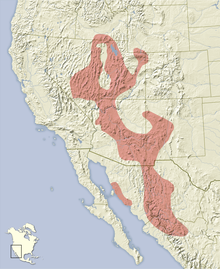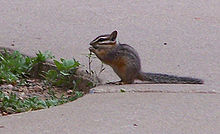Rock chipmunk
| Rock chipmunk | ||||||||||||
|---|---|---|---|---|---|---|---|---|---|---|---|---|

Rock chipmunk ( Tamias dorsalis ) |
||||||||||||
| Systematics | ||||||||||||
|
||||||||||||
| Scientific name | ||||||||||||
| Tamias dorsalis | ||||||||||||
| Baird , 1855 |
The rock chipmunk ( Tamias dorsalis , Syn .: Neotamias dorsalis ) is a type of squirrel from the genus of the chipmunk ( Tamias ). It occurs in the western United States as well as in northern Mexico .
features
The rock chipmunk reaches an average head-trunk length of about 21.7 to 24.9 centimeters, the tail is significantly shorter with 10 centimeters and the weight is about 60 to 75 grams. The back fur of the animals is pale gray, the back stripes typical of the chipmunks are relatively indistinct compared to other species. The central stripe is pale brown to distinctly black and in many animals the only recognizable stripe, sometimes two other stripes are recognizable. There is a white spot behind the ears and the face is marked by two white stripes. The sides of the body are gray to reddish brown, the abdomen is white to cream-colored. The tail is greyish on top, the underside is reddish brown.
distribution
The rock chipmunk is found in the western United States and northern Mexico . The distribution area extends from southern Idaho , eastern Nevada , Utah , southwest Wyoming and northwest Colorado via Arizona and western New Mexico to the Mexican states of Coahuila , Chihuahua , Durango and Sonora .
Way of life
Rock chipmunks live in different habitats within their range, but they are generally associated with structures such as rocks, stone and scree. The most common habitats include pine and spruce forests, juniper stands and oak mountain forests. They often live in the area of river valleys and also in bushes.
The species is diurnal and primarily living on the ground, but can also climb on rock faces as well as in trees and bushes. The animals feed mainly herbivorous of parts of plants, herbs, fruits and seeds of conifers. As opportunists, they also prey on insects and small vertebrates. The essential part of the food, however, is made up of seeds, which are collected in the cheek pouches and sometimes also stored in temporary stores or in the nest as a reserve. Rock chipmunks do not hibernate and can be active all year round, but in bad weather they often retreat to their nest and can stay there for a while. The animals lay their nests in crevices and stone piles. The animals are shy and cautious, they stay close to their nests. The activity area averages 0.9 to 1.3 hectares. Sometimes groups of females were observed looking for food together. Communication takes place via barking calls.
The reproductive time is comparatively long. The males are able to reproduce from January to July, most females mate from April to June. The young are born from late April to August and leave the den between May and September. Some females can have two litters a year, but most females are unlikely to breed every year.
As small rodents, rock chipmunks are prey for a number of predators, most notably birds of prey, martens, cats, dogs, and snakes. In the event of a potential threat, the animals flee under branches and in stone piles or climb trees. They also stand on their back legs and also emit short and shrill alarm calls.
Systematics
The rock chipmunk is classified as an independent species within the genus of chipmunks ( Tamias ), which consists of 25 species. The first scientific description comes from the American naturalist Spencer Fullerton Baird from 1855, who described the species using individuals from the copper mines in "Fort Webster". Arthur Holmes Howell demarcated the area in 1929 to the area of Santa Rita in Grant County , New Mexico. Within the chipmunk group, the rock chipmunk, along with most of the other species, is assigned to the subgenus Neotamias , which is also discussed as an independent genus.
Within the species, six subspecies are distinguished with the nominate form :
- Tamias dorsalis dorsalis : nominate form; occurs from Arizona and New Mexico to northern Mexico. The subspecies is large and comparatively dark with strong colors.
- Tamias dorsalis carminis : the subspecies occurs in two separate regions in the Mexican state of Coahuila. It is dark with clearer stripes.
- Tamias dorsalis grinnelli : in Nevada. The subspecies is pale with indistinct and narrow stripes on the back and face. The subspecies is named after the American zoologist Joseph Grinnell .
- Tamias dorsalis nidoensis : in the Mexican state of Chihuahua.
- Tamias dorsalis sonoriensis : in the coastal area of the Mexican state of Sonora. The subspecies is smaller than the nominate form.
- Tamias dorsalis utahensis : in the northeastern part of the range in Utah, Wyoming, Idaho and Colorado. The shape is smaller and paler than the nominate shape.
Status, threat and protection
The rock chipmunk is classified by the International Union for Conservation of Nature and Natural Resources (IUCN) as "Least Concern" (LC). This is justified by the large distribution area, the assumed large populations and the ability to adapt to different habitats and habitat types. There are no known risks to the company's existence.
supporting documents
- ↑ a b c d e f g h Richard W. Thorington Jr. , John L. Koprowski, Michael A. Steele: Squirrels of the World. Johns Hopkins University Press, Baltimore MD 2012; Pp. 321-322. ISBN 978-1-4214-0469-1
- ↑ a b c Neotamias dorsalis in the IUCN Red List of Threatened Species 2015.4. Posted by: AV Linzey, R. Timm, ST Álvarez-Castañeda, I. Castro-Arellano, T. Lacher, 2008. Accessed May 29, 2016.
- ↑ a b Tamias (Neotamias) dorsalis In: Don E. Wilson , DeeAnn M. Reeder (Ed.): Mammal Species of the World. A taxonomic and geographic Reference. 2 volumes. 3. Edition. Johns Hopkins University Press, Baltimore MD 2005, ISBN 0-8018-8221-4 .
- ^ E. Blake Hart: Tamias dorsalis. ( Memento of the original from March 15, 2016 in the Internet Archive ) Info: The archive link was inserted automatically and has not yet been checked. Please check the original and archive link according to the instructions and then remove this notice. Mammalian Species 399, 1992.
- ↑ Bruce D. Patterson, Ryan W. Norris: Towards a uniform nomenclature for ground squirrels: the status of the Holarctic chipmunks. Mammalia 80 (3), May 2016; Pp. 241-251 doi : 10.1515 / mammalia-2015-0004
literature
- Richard W. Thorington Jr. , John L. Koprowski, Michael A. Steele: Squirrels of the World. Johns Hopkins University Press, Baltimore MD 2012; Pp. 321-322. ISBN 978-1-4214-0469-1
- E. Blake Hart: Tamias dorsalis. Mammalian Species 399, 1992.
Web links
- Neotamias dorsalis inthe IUCN Red List of Threatened Species 2015.4. Posted by: AV Linzey, R. Timm, ST Álvarez-Castañeda, I. Castro-Arellano, T. Lacher, 2008. Accessed May 29, 2016.


